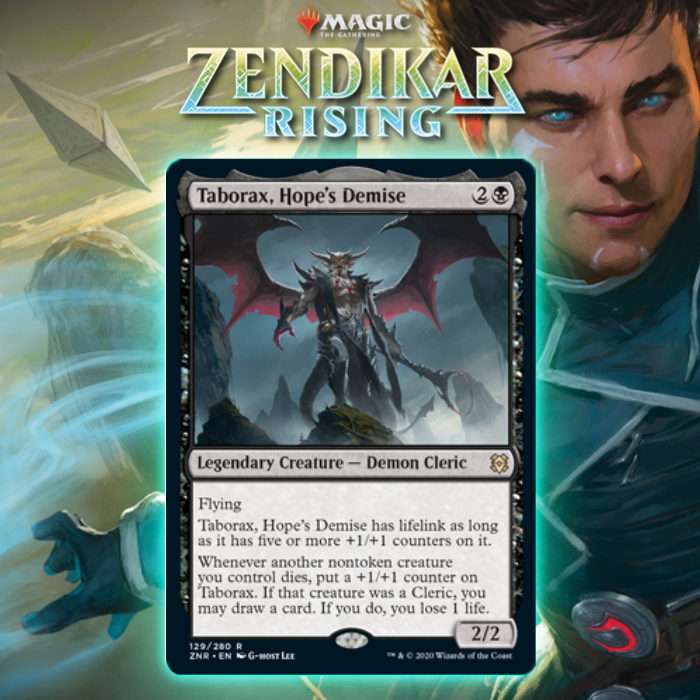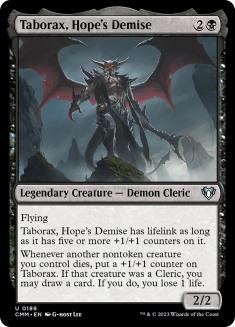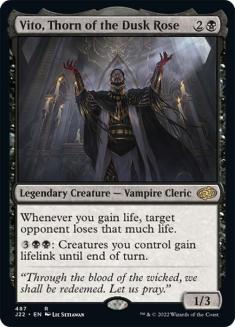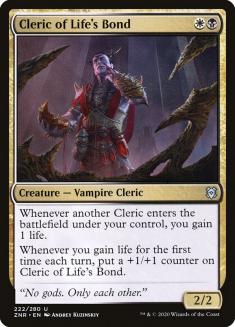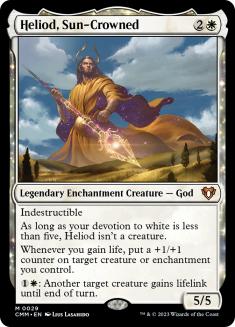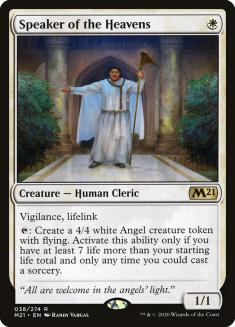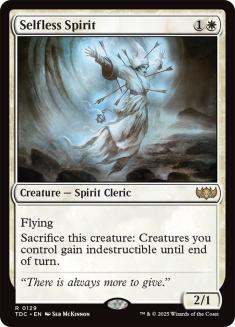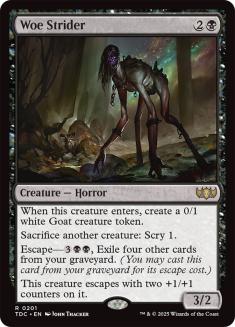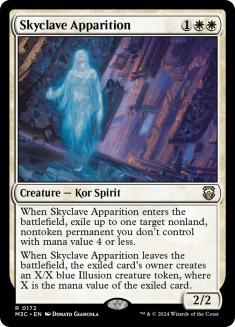I just found a deck that I liked for Standard that could compete with whatever Simic-based monstrosity was dominating the metagame. I could finally relax in the knowledge that I didn’t have to reinvent the wheel each week and could just update my Rakdos deck and put myself in a good position to succeed.
I guess that came a little too late, because now we’re into preview season for Zendikar Rising and the Core Set 2021 Standard season is essentially over, yielding way to a month of focus on Historic while we await the release of another set and what I’m sure is among the most anticipated rotations in quite some time.
So it’s back to the drawing board for me, but I’m hoping to stay in my established comfort zone. Rakdos Sacrifice is losing too many key pieces to survive the rotation, but there are some new cards that might lead to creating a similar deck, headlined by Taborax, Hope’s Demise.
Midnight Reaper has been a staple for most of its time in Standard, and Taborax compares reasonably with it. You have to restrict your deck to mostly Clerics, which sacrifices card quality, but in return you get a significantly upgraded body that has the potential to grow quite large and, more importantly, has evasion.
Midnight Reaper, because it lacked evasion, was often hesitant to enter combat. Sure, you could trade it off for whatever blocker your opponent wanted to throw away and take your extra card in the exchange. That’s often what Midnight Reaper did, and consistently making good exchanges is the path to winning Magic. But Taborax can do so much more. With its evasion, blocking on the ground becomes a nightmare for your opponents, since each trade will net you a card and grow the flyer.
Taborax Doesn’t Party
The first thought to consider when building around Taborax is whether it can contribute to the new party mechanic. And I have to say that the answer is a resounding no.
On the one hand, Taborax clearly wants to be played in an aggressive shell, and cards like Archpriest of Iona and Tazri, Beacon of Unity can beat down with the best of them, but in order to maximize Taborax’s abilities, you need a critical mass of Clerics. Doing that makes it very difficult to incorporate enough of the other creatures in a party to leverage those synergies.
I envision decks trying to build around party to be playing creatures with the best rates while balancing the necessary creature types. It will be an aggro deck that relies on the efficiency of its creatures and dominating the red zone. Taborax would rather be placed in a synergy-driven deck that uses weaker individual cards, but overpowers other decks when its engine gets going. So if I dip into a Warrior or Wizard, it will be because there’s something valuable in the text box, not in the type line.
Unlocking Taborax’s Potential
As the payoff in a synergy-driven shell, you should expect Taborax to become a prime target for opposing removal, as Midnight Reaper was. And because Taborax doesn’t cantrip when it dies, you need to find another way to punish your opponents for targeting Taborax. Doing so requires you to pair Taborax with several high-value creatures which can dominate a game should they stay on the battlefield for too long.
That’s a tough ask given that you also need a significant number of Clerics, but it just so happens that Standard has several creatures that meet those criteria. First is Vito, Thorn of the Dusk Rose, a card that clearly has potential but so far hasn’t found a home. Vito plays perfectly with the Cleric tribal element, since Clerics are well-known for gaining life, which will also mitigate the damage done by triggering Taborax.
Next is another card from Zendikar Rising: Cleric of Life’s Bond. We’ve never seen an Ajani’s Pridemate variant that has a life-gaining ability, and that makes this card particularly scary. It’s hard to ignore Cleric of Life’s Bond as it quickly grows to dominate the battlefield while draining your opponent’s life total via Vito, but if they don’t answer it immediately, then Taborax is there to punish them. When I first read Taborax, I set out to make something with sacrifice synergies, but the card pool pushes us towards a more aggressive shell with these lifegain synergies, a la Soul Sisters.
The last card Taborax can protect is Conclave Mentor. With Pathways, a Triome, and Fabled Passage, I think the splash is workable and Mentor scores very highly on my “takes over the game if left unchecked” metric. Taborax itself can grow out of hand very quickly when you’re skipping every other step. It’s going to be tough to fit all the Cleric synergies, lifegain synergies, and +1/+1 counter synergies in one deck, but the payoff is there.
Let’s look at a list that incorporates all of these elements:
Creatures (31)
- 2 Daxos, Blessed by the Sun
- 4 Heliod, Sun-Crowned
- 4 Vito, Thorn of the Dusk Rose
- 4 Archfiend's Vessel
- 4 Conclave Mentor
- 4 Speaker of the Heavens
- 2 Orah, Skyclave Hierophant
- 4 Cleric of Life's Bond
- 3 Taborax, Hope's Demise
Planeswalkers (2)
Lands (25)
Spells (2)

This list has 25 Clerics, 31 cards that gain life if you include the potential for Taborax to gain lifelink when large enough, and ten cards that dish out +1/+1 counters. That can potentially be balanced out in tuning if Conclave Mentor needs a little help, but I definitely want to stress the lifegain aspect first and foremost, because that’s where the most payoffs are.
In addition to Vito, you have Heliod, Sun-Crowned, which connects the life gain and +1/+1 counter elements, while also being a powerful card in its own right. I’m not as concerned with having the devotion to turn it into a creature, since it will dominate the battlefield either way.
Then you have Speaker of the Heavens, which works perfectly here as a cheap lifelinker to pump Cleric of Life’s Bond and Heliod as well as a payoff for gaining so much life, letting you take over the skies. Decks like this can sometimes lose games because they can’t force through damage on a clogged battlefield, so pumping out a pile of flyers is a great avenue of attack to have. If your opponents can’t answer your new flying army, the option to race is going to be tough against all this lifegain.
The major question here is the manabase. This list has twenty white sources, sixteen black, and thirteen green, enough to consistently cast your spells. Normally 25 total lands would be high for a deck like this, but with four Triomes and two Castles, along with functional mana sinks in Heliod and Vito, this deck can take on the increased land count.
There’s a lot going on here, and it’s possible you want to move away from Conclave Mentor and focus on the other elements, but it’s important to overload your opponent’s removal with high-leverage threats so that you can stick one or two and then figure out how to maximize them in order to take over the game. The variety here also makes the deck quite difficult to play against, since you can lose to a big creature from Conclave Mentor in one game, only to get attritioned out by Taborax the next.
I spent a lot of time trying to make a sacrifice deck with Taborax work as well, but the pieces didn’t seem to be there. Maybe we’ll see something else that fills out the shell later in the preview season, but as is I don’t think it can overcome the loss of Priest of Forgotten Gods. Priest is a Cleric itself, so it would’ve fit perfectly with Taborax, Archfiend’s Vessel, and Call of the Death-Dweller to keep sacrifice decks alive post-rotation.
After lamenting the loss of such a perfect element to the deck I wanted to build for long enough, I decided to look into building the shell in Pioneer. The larger format provides a deeper pool of Clerics to choose from, making it easier to find all the role-players necessary to flesh out the deck’s engine. That said, this isn’t going to be an Aristocrats-style shell because there aren’t enough Clerics that play the roles that style of deck needs to function. Let’s check out what we’re working with:
Creatures (29)
- 3 Bloodsoaked Champion
- 3 Liliana, Heretical Healer
- 4 Selfless Spirit
- 4 Stitcher's Supplier
- 1 Remorseful Cleric
- 4 Priest of Forgotten Gods
- 4 Archfiend's Vessel
- 2 Orah, Skyclave Hierophant
- 4 Taborax, Hope's Demise
Lands (21)
Spells (10)

Running 22 Clerics here is still a solid number, and the seven non-Clerics are critical. Stitcher’s Supplier sets up your Call of the Death-Dwellers and Liliana, Heretical Healers, leading to your most explosive draws, while Bloodsoaked Champion fills the Gutterbones role of providing a steady stream of fodder for Priest of Forgotten Gods as well as a sink for that extra mana. Remember that you can activate Bloodsoaked Champion at instant speed, so declaring it as an attacker and then using Priest and recurring Champion in combat will be a common play when your opponent has plenty of blockers. And while you won’t draw extra cards from Taborax while looping Champion, you will pump the Demon very quickly.
Selfless Spirit ties the whole room together. This deck has Priest and Liliana as high-leverage threats to supplement Taborax, but Selfless Spirit helps protect those cards from removal. It also lets you transform Liliana immediately with little effort, is a great target for Call of the Death-Dweller along with Archfiend’s Vessel since it protects the Demon, and gives the deck some added pressure against decks looking to go over the top.
I’m worried about the lack of overall sacrifice outlets here, so I could see incorporating something like Woe Strider in small numbers, but this deck doesn’t need to sacrifice a ton of creatures to be effective. The goal here is to straddle the line between aggro and sacrifice, so you have these synergies that can overpower decks with bigger creatures, but you can also effectively race the Lotus Field Combo and Temur Reclamation decks that won’t care much about Priest of Forgotten Gods.
Since the deck has so much maindeck space devoted to its own engine, the sideboard is mostly disruptive elements to help out when your own synergies are going to be stymied more often. Dire Tactics is a great, flexible removal spell in a deck with several Humans, while Sin Collector and Arashin Cleric offer valuable effects in specific matchups without detracting from the tribal theme.
Lastly, Skyclave Apparition is my choice for an answer to noncreature permanents because you want to maintain threat density against decks with planeswalkers and such, and its templating of two separate triggers lets you sacrifice it with the enters-the-battlefield trigger on the stack to effectively counter the leaves-the-battlefield trigger. I expect Apparition to show up plenty in Pioneer since it slots so well into the Spirits archetypes, especially those with Collected Company.
Taborax is the most powerful payoff for Clerics since Rotlung Reanimator way back in the days of Onslaught. It takes a lot of moving parts coming together to maximize its abilities, but the power is there, and we may get even more pieces in the coming days since preview season has just begun. Don’t be distracted by the flashy party mechanic that will prevent you from exploiting these powerful tribal synergies. You should be socially distancing anyway.

